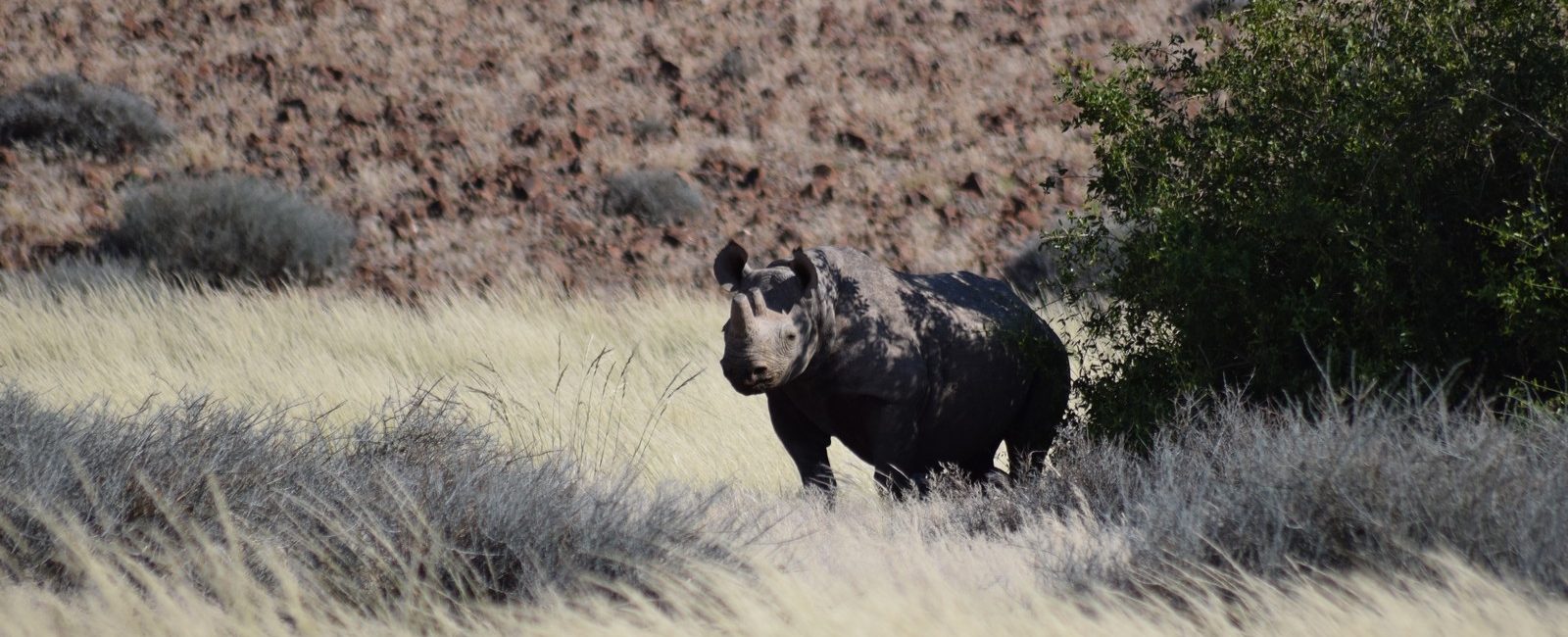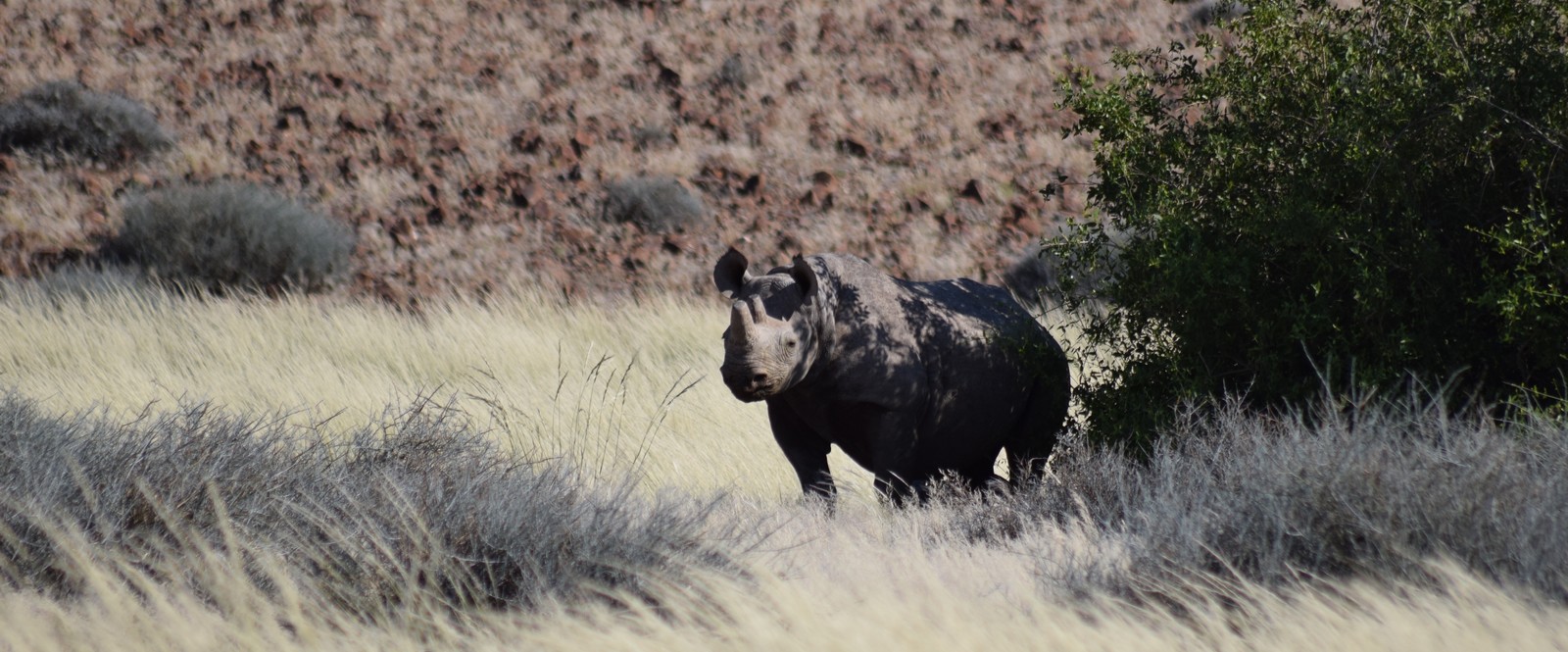

Namibia: Save the Rhino Trust
The Kunene Region of Namibia is a vast, rugged, and remote wilderness, home to a unique population of rhinos: the desert-adapted South-western black rhino (Diceros bicornis bicornis).
Heavily depicted in ancient cave art in the region, these animals have roamed this arid landscape for millennia. They are incredibly tough, able to go several days without drinking, and are one of the few animals that can feed on the highly toxic Damara milk-bush (Euphorbia damarana).
The problem
During the 1970s and 80s, prolonged drought and rampant poaching took a heavy toll on the Kunene Region’s desert wildlife. Little information was known about this habitat and anti-poaching efforts did not exist. By 1982, the black rhino population in the Kunene had been reduced to dangerously low numbers with fewer than 40 individuals surviving in Damaraland and fewer than 10 in Kaokoland to the north.
Save the Rhino Trust was formed to reduce poaching and save these animals from the brink of extinction. Its approach was simple but highly effective: offer local people a more secure livelihood as wildlife guards. After three decades of Save the Rhino Trust’s pioneering efforts and collaboration with the Namibian government and communities, the black rhino population grew steadily in size. The region is now home to the last truly wild population of any rhino species on the planet. The country itself hosts almost 35% of the world’s remaining black rhino population, and 84% of the South-western subspecies.
How is Save the Rhino Trust tackling this problem?
Save the Rhino Trust (SRT) has established an extensive database documenting, through photographic and life-history records, Kunene’s black rhinos. Given the continued threats posed in Namibia by organised criminal gangs, it is essential that Save the Rhino Trust maintains its intensive patrolling, which, based on poaching data, is a contributing factor to deter potential poachers. In the process, other species on the landscape such as desert lions, elephants, and giraffes also benefit from the increased surveillance and monitoring activities. Mensley Karutjaiva of the Torra Conservancy, had this to say about why he became a Rhino Ranger:
“I would like to protect wild animals for future generations, for children and our children’s children to see. I don’t want to show them drawings. I want to show them the real animal.”
Whilst the rangers are incredibly passionate about what they do, SRT provides additional incentives in the form of payments and award schemes to reward them for their efforts. Using data collected by Spatial Monitoring And Reporting Tools (SMART) technology, bonuses are received by each ranger for the number of foot-kilometres travelled, the number of rhinos sighted and recorded, and the variety of different rhinos recorded. These payments further motivate the rangers in the field and provide an additional boost for the local economy, helping to emphasise the importance of wildlife for local people in the process.
However, whilst these ‘boots on the ground’ have been highly effective, some areas are simply too vast and remote to reach easily. In 2021, a new Mule Patrol Unit (MPU) was established to help the teams cover greater distances. These ‘hooves on the ground’ are incredibly well cared for and have already been put to good use, searching for and locating all rhinos that had been displaced by the sudden onset of mining activities in their habitat.
With the success of SRT becoming increasingly apparent, it was recently decided that SRT would expand its focus for the first time in 40 years. Rhino monitoring and patrol activities have been expanded eastwards and Rhino Rangers have been trained to monitor a newly founded population of black rhinos in the Nyae Nyae Conservancy. The first patrols began at the beginning of 2022, helping to keep an additional 6,000 km² of suitable habitat safe for a newly established black rhino population. It is hoped that this success will be further replicated and expanded to other areas of Namibia soon.
Our work
Due to the vast distances that need to be covered across rugged desert terrain, rhino monitoring operations can take their toll on vehicles, making this is a significant cost. This has been made worse by the current global economic situation, which has seen the cost of fuel in Namibia by almost 40%.
As well as supporting the purchase of vehicles and fuel, Save the Rhino funds personnel costs, rations for staff on patrols, uniforms, and the costs of running Save the Rhino Trust’s operations, including the base camps. One such base is currently under construction for a new Mule Patrol Unit camp and our funds have also been allocated towards the digging of boreholes and construction of a fence to protect the mules from hungry lions.
With SRT’s work expanding into the Nyae Nyae Conservancy, we have also funded the purchase of remote camera traps, SMART devices, rations, salaries, and solar charging systems to aid the monitoring efforts carried out by the newly trained local rangers here.
We have supported Save the Rhino Trust since the early 1990s with grants from our funds as well as through fundraising events (Desert Trek Namibia in 2005 and Rhino Cycle Namibia for many years) and assisting fundraising applications. Since 2006, we have sent each of our Michael Hearn Interns (named after SRT’s charismatic Director of Research, who died too young in 2005) to Namibia to spend time working with the team.
What can you do?
The value of black rhino recovery to the local people of the Kunene has been strengthened by the establishment of responsible rhino safaris for exclusive tourism adventures.
In 2003, SRT, in collaboration with the tourism company Wilderness Safaris, created the Desert Rhino Camp (DRC). This unique experience enables tourists visiting Namibia to join the Rhino Rangers on monitoring patrols while they search for the desert’s black rhinos. Much of the funds generated from these activities are ploughed back into SRT’s running costs and the tracking team based here is funded entirely by this venture. Visiting the Kunene Region and staying at DRC or one of the lodges owned and run by local communities to see the famous desert-adapted black rhinos not only generates income for the communities but also demonstrates the value of protecting the Region’s wildlife.
A Conversation with Simson Uri-Khob
 Protecting Rhinos
Protecting Rhinos
 Reducing Illegal Horn Trade
Reducing Illegal Horn Trade
 Involving Communities
Involving Communities
 Bringing Experts Together
Bringing Experts Together





